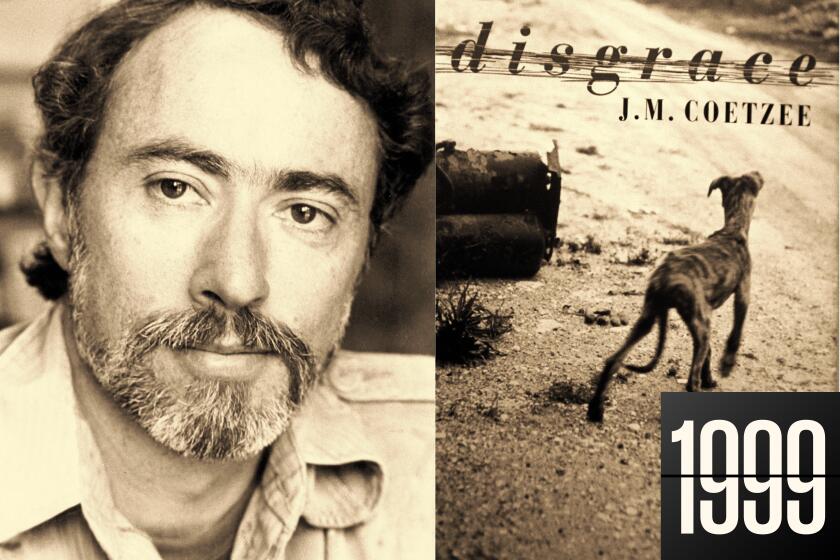Earth Angel : CONFESSIONS OF AN ECO-WARRIOR, <i> By Dave Foreman (Harmony Books: $19.95; 240 pp.)</i>
It has been almost a decade since that fine morning in March, 1981, when five figures staggered across the concrete walkway atop Glen Canyon Dam in Page, Ariz.; attached the ropes of a long, awkward bundle they were carrying to the grill of the protective railing, and with a mighty yell to 75 comrades standing downstream on the Colorado River bridge, let 300 feet of black plastic in the shape of an enormous crack unfurl down the concave face of the dam. A wisecrack, if you will. A homage to the spirit of Edward Abbey’s novel of environmental sabotage, “The Monkey Wrench Gang.” And a welcome to the first national gathering of a new radical environmental group, Earth First!
Earth First! was born out of a frustration with mainstream conservation organizations and their conciliatory stance toward the amount of public lands that should be included in the National Wilderness Preservation System. It was conceived as an antidote to the “genteel” approach, to a willingness to compromise with pro-ranching, -mining, -logging, off-road-vehicle forces by a career-oriented, mainstream leadership that seemed to regard conservation more as a profession and less as a cause. What was needed was a radical fringe that would pull the mainstream along, remind it of its philosophical base, and at the same time raise an army of eco-warriors committed to demonstration and engagement, to action and deed rather than rhetoric.
As any observer of the conservation movement knows, Earth First! with its clenched-fistposture and “no compromise in defense of Mother Earth” credo has inspired more pop-eyed rage among pro-development opponents, more furious debate over spiking trees and “decommissioning” heavy equipment as a legitimate form of civil disobedience, more fear and loathing among politicians who serve timber, mining, and grazing interests, and more adverse national press than practically any activist alliance since the Wobblies--whose habit of industrial sabotage during World War I is mimicked by Earth First! “ecotage” (known as monkeywrenching).
And no member of Earth First! has been singled out for more of the attention than its co-founder, Dave Foreman, author of the infamous manual on environmental “vandalism,” “Ecodefense: A Field Guide to Monkeywrenching,” and for 10 years the movement’s most articulate spokesman and passionate explicator. Now he has written a new book, “Confessions of an Eco-Warrior,” and we learn, if we didn’t already know, that Foreman’s conservation activities have been considerably more varied and constructive than his media reputation suggests.
“Confessions of an Eco-Warrior” is not an easy book to pin down. It is not exactly a memoir, or a dialectic, or a history of radical environmentalism, or a discourse on Deep Ecology--though it wanders around in all these subjects. It doesn’t confess to anything except a biocentric world view and a profound dedication to wilderness preservation. And it is not exactly a prescription for the future, though it contains thoughtful and specific ideas about the management of what little remains of our undeveloped world.
After 20 years in the conservation movement (including 10 years as a “mainstream” Wilderness Society representative), Dave Foreman is a man who knows whereof he speaks, and the most evocative parts of his narrative are the chapters concerning the development of a meaningful National Wilderness Preservation System (“Dreaming Big Wilderness”) and the creation of “primeval” wilderness areas (“Preserving the Wilderness Experience”) where trails, signs, maps, guides, search-and-rescue missions and the use of modern backpacking equipment all would be disallowed.
The primary motivation for “Confessions of an Eco-Warrior” seems to be the detailed defense of those principles upon which Earth First! originally was founded--biocentrism, wilderness preservation for the protection of biological diversity (not for scenic or recreational or resource reasons), strategic monkeywrenching as a valid conservation tool. But there is a subtext throughout all this that only becomes explicit in the final chapter, “Whither Earth First!” Readers will perhaps be surprised to learn that Foreman has divorced himself from the Earth First! movement. “I no longer represent it and I am no longer represented by it.”
What is this, we ask? Is this true? This tough ex-Marine whose beard, black watch cap, fatigues, raised fist and war cry “No compromise in defense of mother earth” we associate with radical environmentalism has forsaken his own stepchild? “(I) find it difficult,” he writes, “to advocate ecological wilderness restoration within a movement now dominated by anti-capitalist rhetoric and an overwhelming emphasis on direct action to the exclusion of other traditional Earth First! techniques.”
It is Earth First! that has changed course, not Foreman. Like all revolutionary movements, it has fragmented into a variety of splinter groups, many of them having little to do with biocentrism and wilderness preservation, all of them arguing a different style and philosophy. A good many recent converts to the cause seem primarily enthralled by the vision of chaotic anarchy they associate with civil disobedience; they are motivated by opposition to authority and anti-Establishment behavior, not by the biological crisis that faces this planet. Other groups, perhaps more legitimately inspired, have replaced problems of ecological degradation with anthropocentric issues of social injustice, and have exchanged a dedication to wilderness preservation for a dedication to the class struggle. It is a fundamental “humanism,” not biocentrism, that motivates these folks.
And there has been, moreover, a gradual cheapening of the meaning of environmental civil disobedience by all the counterculture sloganing, and by what Foreman refers to as kiddie pranks, like shopping-mall puke-ins and flag burnings. He wishes these “new” Earth Firsters well, including the “feral adolescents”; he even argues (though not very convincingly) that they may serve some useful purpose. “I will continue to applaud the courageous actions of those operating with the Earth First! name,” he says, but “it is time for me to build a campfire elsewhere.”
Although Foreman never has been a revolution-for-the-hell-of-it kind of activist (“I am not an anarchist or a Yippie. I am a conservationist”), it seems highly unlikely we will find him camped anywhere near the boneyard of moderation. Still, the whole temper of “Confessions of an Eco-Warrior” suggests that in spite of his belief in diversification and his enthusiasm for confrontational engagement, the applause for much of what now passes as courageous action in the “new” Earth First! movement may well be the sound of one hand clapping.
More to Read
Sign up for our Book Club newsletter
Get the latest news, events and more from the Los Angeles Times Book Club, and help us get L.A. reading and talking.
You may occasionally receive promotional content from the Los Angeles Times.






